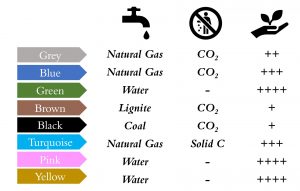Hydrogen plays an important role in the race for a sustainable future but its world is not as simple as it initially appears to be.
Hydrogen is an energy carrier which can be produced from a wide variety of sources. Low-carbon hydrogen does not currently hold a large part of the global energy market but it is considered to be highly attractive due to its potential and versatility. Forbes magazine states that shares with meaningful exposure to hydrogen have been among the best performing in the bull run of energy transition stocks in the last few months.
EU published its strategic goals towards hydrogen technologies, aiming for 6 gigawatt (GW) of capacity by 2024, reaching 40 GW by 2030. Many European countries including but not limited to Germany, Spain, Portugal, Netherlands and Sweden published a national hydrogen strategy in the last year.
As with many things in life, the hydrogen world is not as simple as it first appears. We are increasingly hearing more and more about blue and green hydrogen while the last few years all the colours of the rainbow have been used to identify hydrogen. But what does this actually mean?
Grey hydrogen: Grey hydrogen usually refers to the hydrogen produced from fossil fuels without capturing any greenhouse gases produced in the process. Grey hydrogen produced from the reforming of natural gas accounts for ~70% of the global production of hydrogen today.
Blue hydrogen: Blue hydrogen is produced in the same way as grey hydrogen but the by-products of the process, ie carbon dioxide, are captured, and not released directly in the atmosphere. Many people consider blue hydrogen to be ‘low-carbon hydrogen’ as the above described process does not really exclude the creation of greenhouse gases.
Green hydrogen: Green hydrogen, is the hydrogen produced using renewable electricity via electrolysis technologies. In this process an electrochemical potential is used in order to split water into its components, hydrogen and oxygen, emitting zero carbon dioxide. Currently, it is estimated that green hydrogen makes up to ~1% of the global hydrogen production. To split water, the electricity needed is harvested by renewable energy sources. Such sources are wind or the sun. That makes green hydrogen one of the cleanest and most promising options for the future.
There are more colours in the rainbow
This is where things start to get complicated. Depending on the hydrocarbon used and how much carbon dioxide it releases, grey hydrogen is known as brown or black hydrogen. Brown hydrogen comes from the reformation of lignite (brown coal) while it becomes Black hydrogen if it is a result of coal burn. Grey, brown and black hydrogen account for ~95% of the global hydrogen market.
Turquoise hydrogen: Turquoise hydrogen is produced from methane pyrolysis, when methane/ natural gas is directly split into hydrogen and solid carbon. Turquoise hydrogen is still a low-emission hydrogen choice but storing solid carbon is still an issue. Additionally, the efficiency and the high energy demands of its production are questionable factors to consider if it was to be used in large scale. However such issues could be partially overcome if the process is being powered by renewable energy.
Pink hydrogen: Pink hydrogen refers to hydrogen produced via electrolysis, as green does, but the electricity demands are powered by nuclear energy.
Yellow hydrogen: Yellow hydrogen refers to hydrogen produced via electrolysis, as green and pink do, but the electricity demands are powered by solar energy. However, some refer to hydrogen as yellow when the electricity demands are met from a mix of renewable and fossil power sources.
What colour is the future?
The future of hydrogen is a clear transition from grey, through blue, to green hydrogen. However, the hydrogen transition in different parts of the world has an approach that spans the hydrogen colour palette. In any case it is clear that hydrogen will play an important role in the energy transition of the future.

RELATED ARTICLES
CONTACT US
____________
greekwomeninstem@gmail.com
Do you have ideas, questions, comments or special requests?
Would you like to highlight your research project or nominate a researcher that you would like to learn more about?
Please write to our email or fill out the form and hit “send”. We will be happy to talk with you!
[contact-form-7 id=”44″ title=”Contact form 1″]
